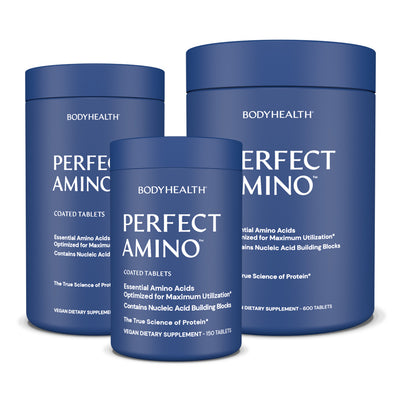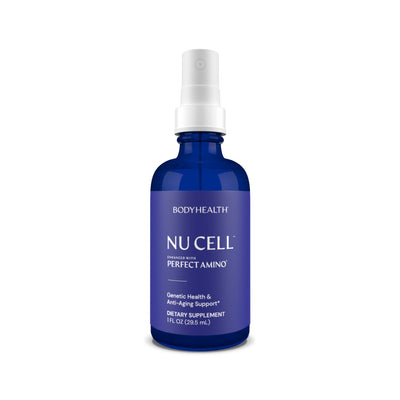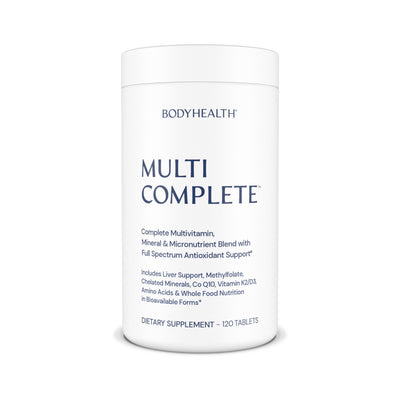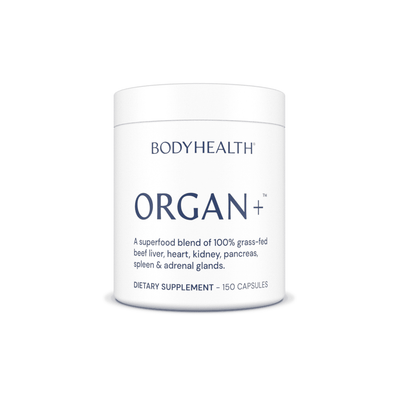DNA & RNA: How PerfectAmino Helps Optimize The Process Of Protein Synthesis
by Dr David Minkoff April 21, 2024 8 min read

We’ve upgraded PerfectAmino by adding nucleotides and nucleosides — the building blocks of nucleic acids: our DNA and RNA.
But we want to make sure you fully understand why we did this and how this works.
Because it was for a very exact reason. And it is very much an upgrade.
We know that the building blocks of protein and collagen are the essential amino acids.
Having all of the essential amino acids, and having each of them in the correct overall ratio, is necessary for complete protein synthesis, as well as protein synthesis without the caloric impact.
However, there is another aspect to this.
While these essential amino acids are the material used to synthesize new protein, the actual building blocks of protein and collagen, if we want perfect protein synthesis then we need to look at the process of synthesizing protein itself: how they are being made.
Because if the process is at all faulty, then even if we have the correct amino acids and correct amounts, we won't necessarily get correctly made proteins.
In fact, we can even have stopped creation of specific proteins. And that can affect us in any number of ways.
This process is controlled by:
Our DNA, the blueprints that say how to build new proteins.
And our RNA, the messenger molecules that not only pass on the information from our DNA, but actually direct the synthesis of new proteins, and build the new proteins, amino acid by amino acid.
If the DNA (blueprints) or RNA (messenger molecules) are in any way corrupted from toxins coming in, harmful bacteria, or just plain aging, this can result in faulty protein synthesis.
And this can result in cells, enzymes, and hormones that are less functional than they should be, and even premature aging.
But even more, in many cases, if DNA repair has not occurred, and until it occurs, protein synthesis of specific proteins are stopped.
Fully.
So our cells don’t even produce those needed proteins until the DNA repair has occurred.
Which proteins and how does this affect us?
Well, there are over 20,000 different proteins made in the human body, and hundreds to thousands of different protein synthesis points on each different DNA strand.
Where damage occurs will be different for every one of us. And what that results in will also be different.
Do you see how important this is?
From Molecular Biology Of The Cell, 4th edition: DNA Repair:
“The flow of information from DNA to RNA to proteins is one of the fundamental principles of molecular biology. It is so important that it is sometimes called the “central dogma.”
By providing nucleosides and nucleotides, the building blocks of our nucleic acids (our DNA and RNA), we give our cells what they need to help repair faulty DNA and RNA, thus improving the process of protein synthesis itself.
But I want to make sure you fully understand how this works. So let’s dive in and break it all down.
WHAT IS DNA & RNA?
Okay, first we need to define some things.
Every cell contains DNA, the exact blueprints on how to build the human body — exactly. Every protein. Every cell. Everything.
But it goes deeper. Because the full blueprint is housed in smaller sections called “chromosomes.” You’ve probably heard of these.
Each chromosome houses a different part of our overall DNA, or blueprint.
Here is a picture of a DNA strand in a chromosome.
So each chromosome contains a very long strand of DNA that is individual to that chromosome.
Then, small snippets of this strand, or “sequences,” are called “genes.” And each chromosome contains anywhere from a few hundred to a few thousand different genes or “gene sequences.”
These genes are like mini blueprints for various aspects of the body. Different gene sequences say how to make different proteins.
And all of this together is collectively called our DNA.
You can see a simple picture of each part broken down here.
So from our overall DNA (blueprint) we get it divided into long, individual strands called chromosomes, and these strands are divided into much smaller pieces called genes.
For analogy, if DNA was the blueprint for a city…
Chromosomes would be large parts of that blueprint with one saying how buildings are made, one saying how houses are made, one saying how the electrical grid is made, one for the water supply, etc.
Then we get pieces of the chromosomes called genes, which are the smaller aspects: how to make a door for a house, how to put in plumbing for a house, how to put in the flooring, etc.
Do you see how this works?
All of this is DNA, just broken down into smaller and smaller pieces.
And one of the biggest things our DNA says how to do is… build new protein.
Different gene sequences actually say how to build different proteins. And there are over 20,000 different protein forms in the human body.
But how our genes communicate these directions to the cell is through molecules called RNA and mRNA.
These are messenger molecules. They copy the information from a specific gene and then direct the cell on how to make protein.
This is called “transcription.” They’re making a transcription from the overall notes.
So how does this lead to protein synthesis?
HOW DNA & RNA SYNTHESIZE NEW PROTEIN & COLLAGEN
From Molecular Biology Of The Cell, 4th edition: DNA Repair:
“The first step a cell takes in reading out a needed part of its genetic instructions is to copy a particular portion of its DNA nucleotide sequence gene into an RNA nucleotide sequence.”
And:
“The majority of genes carried in a cell's DNA specify the amino acid sequence of proteins; the RNA molecules that are copied from these genes (which ultimately direct the synthesis of proteins) are called messenger RNA (mRNA) molecules.”
So we have the blueprints, and the RNA then copies these blueprints and directs the cell on how to build the new protein needed.
Getting even deeper, from the National Library of Medicine: How Do Genes Direct The Production Of Proteins:
“The journey from gene to protein is complex and tightly controlled within each cell. It consists of two major steps: transcription and translation…
“During the process of transcription, the information stored in a gene's DNA is passed to a similar molecule called RNA (ribonucleic acid) in the cell nucleus [picture].
“Both RNA and DNA are made up of a chain of building blocks called nucleotides, but they have slightly different chemical properties.
“The type of RNA that contains the information for making a protein is called messenger RNA (mRNA) because it carries the information, or message, from the DNA out of the nucleus into the cytoplasm [the liquid that fills the inside of the cell].”
That is transcription, or the copying of the blueprint data from the DNA into the RNA messaging molecule. Then there is translation of that information:
“Translation, the second step in getting from a gene to a protein, takes place in the cytoplasm [the liquid that fills the inside of the cell].
“The mRNA interacts with a specialized complex called a ribosome [the structure in a cell where protein synthesis occurs], which "reads" the sequence of mRNA nucleotides.”
Remember, nucleotides and nucleosides are the building blocks of these DNA and RNA.
“Each sequence of three nucleotides, called a codon, usually codes for one particular amino acid. (Amino acids are the building blocks of proteins.)
“A type of RNA called transfer RNA (tRNA) assembles the protein, one amino acid at a time. Protein assembly continues until the ribosome encounters a “stop” codon (a sequence of three nucleotides that does not code for an amino acid).
“The flow of information from DNA to RNA to proteins is one of the fundamental principles of molecular biology. It is so important that it is sometimes called the “central dogma.”
So we have DNA that contains the full blueprint, and genes which are small snippets of this blueprint.
The mRNA (messenger molecule) takes the information from the gene to where proteins are synthesized in the cell, and tRNA (the transferring molecule) assembles each individual protein, one amino acids at a time.
Do you see how intricate this is?
By providing the building blocks of nucleic acids (our DNA & RNA) we provide our cells with the materials they need to repair the protein building structures in the cells themselves, thus helping to optimize protein synthesis of the essential amino acids in PerfectAmino.
HOW NUCLEOTIDES & NUCLEOSIDES HELP REPAIR DAMAGED DNA & RNA
Okay, now we’re going to get very technical.
I’ve quoted key references and linked to them so you can look through them if you like, but note, they do get quite technical. So I’ve only quoted key aspects and you can pursue the rest of the research studies for each if you like via the links provided.
There are many environmental factors that can cause damage to our DNA and RNA, causing faulty protein synthesis.
However, our cells have the ability to repair this damage.
The building blocks of nucleic acids — DNA & RNA — are nucleosides and nucleotides.
From Nucleotide Excision Repair in Eukaryotes:
“Recent studies have led to a detailed understanding of the NER mechanism and its regulation in the context of the cell.
“Nucleotide excision repair (NER) is the main pathway responsible for the removal of bulky DNA lesions induced by UV irradiation, environmental mutagens, and certain chemotherapeutic agents.”
And, from Molecular Biology of the Cell, 4th edition: DNA Repair:
“There are multiple pathways for DNA repair, using different enzymes that act upon different kinds of lesions…
“… major repair pathway is called nucleotide excision repair. This mechanism can repair the damage caused by almost any large change in the structure of the DNA double helix.”
“Human cells contain more than ten minor DNA polymerases, many of which are specifically called into play, as a last resort, to copy over unrepaired lesions in the DNA template. These enzymes can recognize a specific type of DNA damage and add the nucleotides that restore the initial sequence.”
“Genetic information can be stored stably in DNA sequences only because a large set of DNA repair enzymes continuously scan the DNA and replace any damaged nucleotides.”
Do you see how important this is?
“We have just seen that cells contain multiple enzyme systems that can recognize DNA damage and promote the repair of these lesions. Because of the importance of maintaining intact, undamaged DNA from generation to generation, cells have an additional mechanism that helps them respond to DNA damage: they delay progression of the cell cycle until DNA repair is complete. For example, one of the genes expressed in response to the E. coli SOS signal is sulA, which encodes an inhibitor of cell division. Thus, when the SOS functions are turned on in response to DNA damage, a block to cell division extends the time for repair. When DNA repair is complete, the expression of the SOS genes is repressed, the cell cyle resumes, and the undamaged DNA is segregated to the daughter cells.
“Damaged DNA also generates signals that block cell-cycle progression in eucaryotes. As discussed in detail in Chapter 17, the orderly progression of the cell cycle is maintained through the use of checkpoints that ensure the completion of one step before the next step can begin. At several of these cell-cycle checkpoints, the cycle stops if damaged DNA is detected. Thus, in yeast, the presence of DNA damage can block entry into the G1 phase; it can slow DNA replication once begun; and it can block the transition from S phase to M phase. The DNA damage results in an increased synthesis of some DNA repair enzymes, and the delays further facilitate repair by providing the time needed for repair to reach completion.”
IN SUMMARY
While essential amino acids are the building bocks of protein and collagen, there are key molecules (DNA & RNA) that direct the process of actually using these essential amino acids to build new proteins.
When our DNA and RNA are damaged in some way, this can result in either faulty proteins being produced, or specific proteins not being produced until the damaged DNA is repaired.
By adding Nucleotides and Nucleosides to PerfectAmino, we not only have the building blocks of protein and collagen, we now have the building blocks of the nucleic acids (DNA & RNA) that direct the synthesis of these amino acids into new proteins.
These are the elements our DNA and RNA use to repair damaged genes for proper protein synthesis.
This is the largest advance in protein utilization in the last few decades.
We hope you're excited as we are about it.
REFERENCES:
Articles by Health Topic
Get “The Search for the Perfect Protein”
by Dr. David Minkoff
Signup for the BodyHealth Newsletter and get a FREE digital copy of "The Search for the Perfect Protien" by Dr. David Minkoff and discover the key to weight loss, depression, fatigue, insomnia, and osteoporosis!
*These statements have not been evaluated by the Food and Drug Administration. These products are not intended to diagnose, treat, cure, or prevent any disease.




